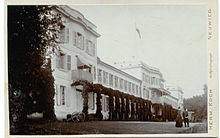Monrepos Castle (Neuwied)

The Monrepos castle was a baroque palace of the Prince of Wied in Neuwied . At first it had the French name “Montrepos” (dt. “Bergruhe”), later it became “Monrepos” (dt. “My calm”), following the zeitgeist. It was built in the period from 1757 to 1762 by order of Count Alexander von Wied-Neuwied near the Hanhöfe above the family castle Altwied by Behagel von Adlerskron from Frankfurt and served in the 19th century as the summer residence of the princely family. Artful, playfully designed gardens with small hermitages were laid out around the castle.
architecture
In its origins, the castle was an elongated structure with a total of 31 window axes with a flat roof and connected to two-storey buildings on the left, in the middle and on the right. All three were slightly vaulted in the middle, the roof parapet decorated with statues, vases and coats of arms.
Around 1844/45 the entire building was raised by one floor. The now three-storey central and corner buildings received balcony porches. The entire castle was painted snow-white and now stood out well against the dark forest from a distance. It was popularly known as the “White Castle”.
Close to the castle are the Princely-Wiedische forest cemetery, the Carmen-Sylva resting place, the so-called kitchen house, the stables from 1890, the forest and residential house and the very first stables, also known as the bakery. All buildings were inhabited. In 1795, because of the First Coalition War, the Neuwied Knabenanstalt of the Brethren was relocated to Monrepos.
On December 23, 1843, Princess Elisabeth zu Wied was born at Monrepos Castle and grew up there. She later became known as Carmen Sylva as a poet and Queen of Romania .
Between the world wars of the 20th century, the castle was hardly used, eventually remained completely empty and fell into disrepair over time. Since the maintenance costs for the castle were too high and no interested party could be found, the then owner Friedrich Wilhelm Fürst zu Wied, with state approval, arranged for the Niederbieber volunteer fire department to resign it on April 30, 1969 using 100 liters of gasoline and 300 liters of crude oil.
Sweden House
The Swedish house was built in 1888 in the Scandinavian wooden style for the Swedish Crown Prince and later King Gustav V as a hunting lodge. In 1981, the former Paleolithic research center of the Roman-Germanic Central Museum (today: Monrepos Archaeological Research Center and Museum for Human Behavioral Development ) was established there, and in 1988 it was moved to the “Waldheim”.
Waldheim Monrepos
In 1909 the villa “Waldheim” (also called “Palace of the Princesses”) was built in the immediate vicinity of Monrepos Castle. It was the residence of the widow of Prince Wilhelm zu Wied and her children Princess Elisabeth and Princess Luise. After Luise's death in 1965, the house remained uninhabited.
In 1979 the 24-hour police exercise "Loreley" was carried out there with over 400 police officers. That was the largest police exercise since the Federal Republic was founded. From 1986 the palace was converted into a museum and opened in 1988 as the Monrepos Ice Age Museum.
Blessing house
Before you get to the parking lot, turn left to the former Monrepos ski hut. In front of the wrought-iron entrance gate with the initials S H, for "blessing house", there is an old gatehouse and a little further on another house, the so-called Amselheim, which also belonged to the palace complex. The blessing house, the name goes back to the village of Segendorf , was a villa in the style of an Italian country villa. From 1872 to 1902 the house was the widow's residence of Princess Marie zu Wied, Carmen Sylva's mother. She lived here during her exile from 1892 to 1894 and also when she visited Germany. The Dutch Queen Emma , a niece of Princess Marie, also liked to come to the Blessing House to relax. According to plans by the Princess and Carmen Sylvas, the house was to become a court of muses for artists from all over the world.
Since the heirs had lost a lot of money during the period of inflation , the house could not be maintained and gradually fell into disrepair. In 1961 the ruins were leveled during a military exercise.
In the forest around Monrepos, exotic trees are planted that Prince Maximilian zu Wied brought back from his research trips.
Today, the Monrepos Archaeological Research Center and Museum of Human Behavioral Development is located in the Palais der Prinzessinnen . The part attached to the princess house at an angle was called the "badger's den".
literature
- Albert Meinhardt: Neuwied then and now. With pen and ink through the new urban area. 2nd edition, updated. Kehrein, Neuwied 1995, ISBN 3-9803266-4-0 .
- Heinrich Neu and Hans Weigert: Die Kunstdenkmäler des Kreis Neuwied , L. Schwann, Düsseldorf, 1940, pp. 266–270.
Web links
- MONREPOS - Archaeological Research Center and Museum of Human Behavioral Evolution
- Report on the fire
- 1969 Monrepos Castle burns
Individual evidence
- ↑ Bernd Willscheid: Monrepos Castle. In: Heimat-Jahrbuch des Neuwied district. 1991, ZDB -ID 401745-6 , pp. 96-98.
- ↑ Wilhelmina : Lonely and yet not alone . Evangelisches Verlagswerk, Stuttgart 1961, p. 24.
Coordinates: 50 ° 28 ′ 55.2 " N , 7 ° 26 ′ 40.6" E




